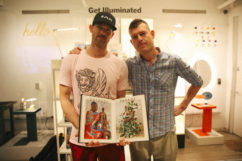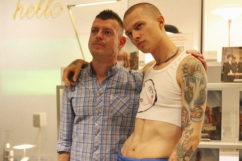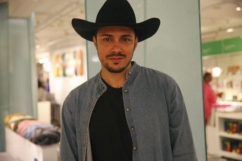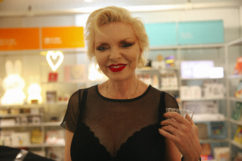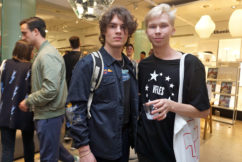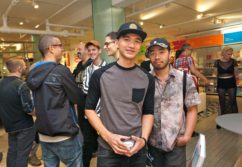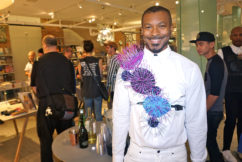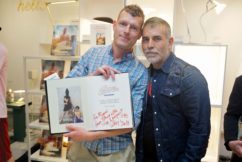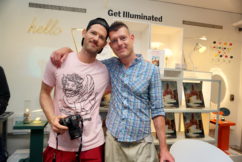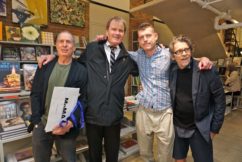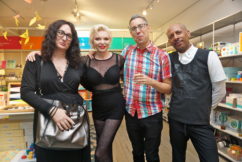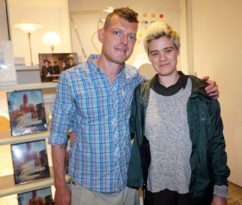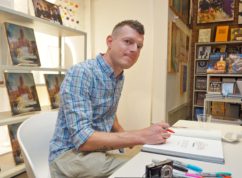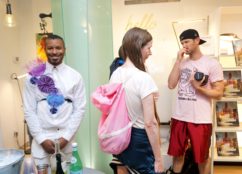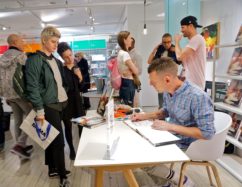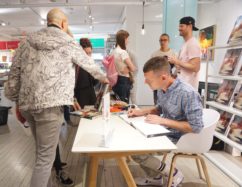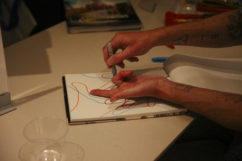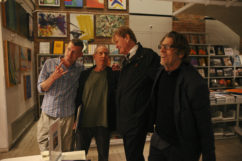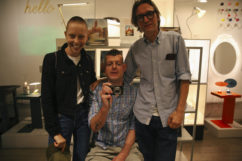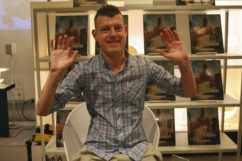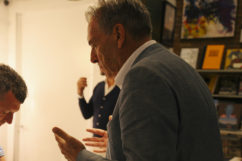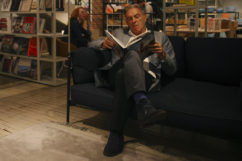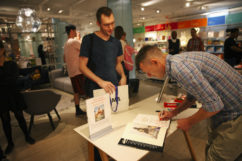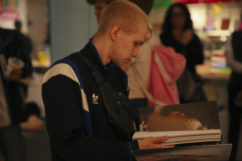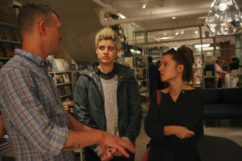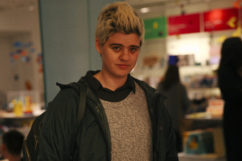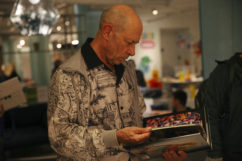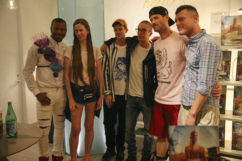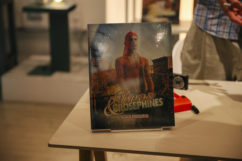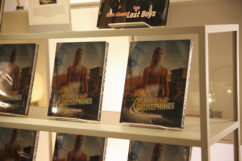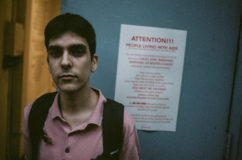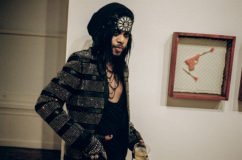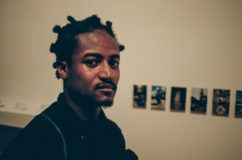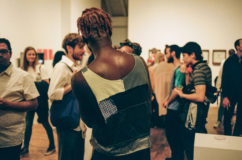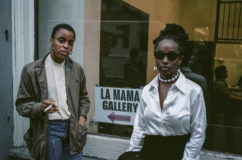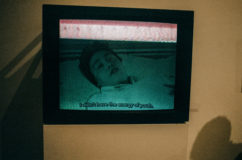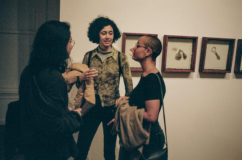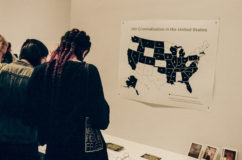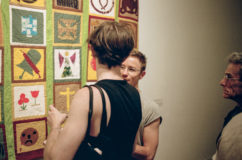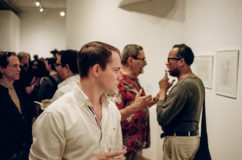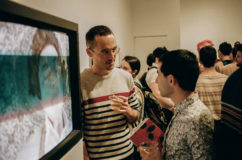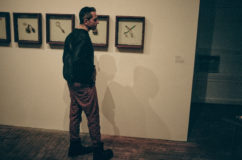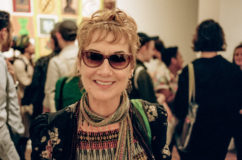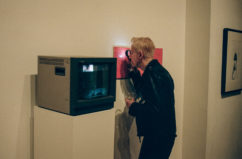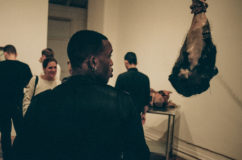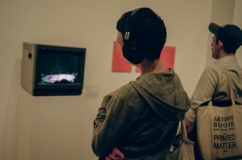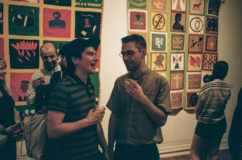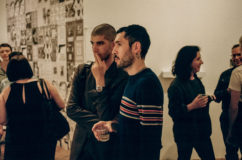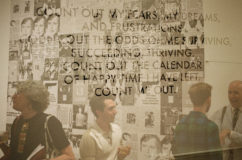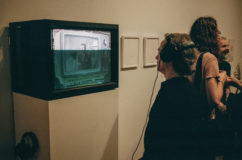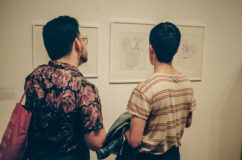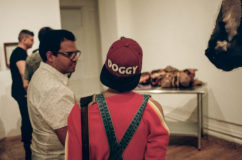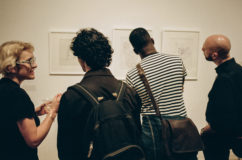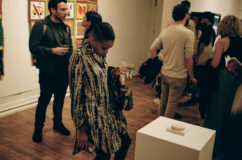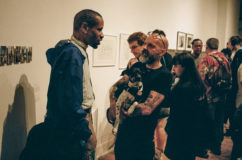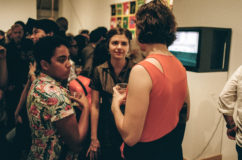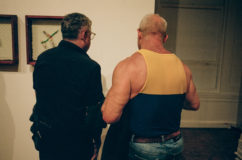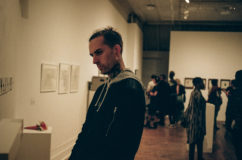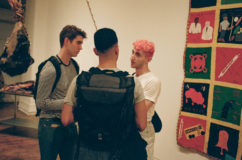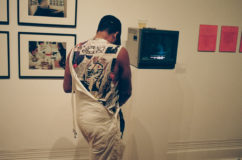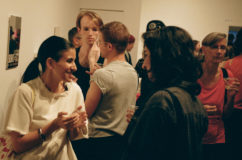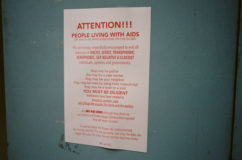Monday 07.16.18
OUT FOR THE CAMERA: The Self-Portraits of Leonard Fink
Scenes of the sexual, the social and the historic at this intimate exhibit.
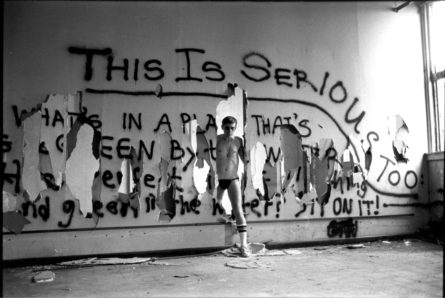
As a newcomer to New York City I made my first trip to the Leslie-Lohman Museum of Gay and Lesbian Art in Soho a couple of weeks ago. I arrived dazed and sticky, not yet used to the stifling midsummer heat or the Canal St. crowds. The museum, on the comparatively quiet corner of Wooster and Grand, felt like a place of refuge. I felt weary and immediately grateful as I walked in. Inside the museum is both stark and warm. With its soft lights and wood floors the gallery space cultivates a comfortable intimacy in its visitors. The same intimacy naturally carries through to the relationship between the visitors and the exhibitions, between the visitor and the art. As I explored OUT FOR THE CAMERA: The Self-Portraits of Leonard Fink, one of the two exhibits currently on view at the museum, the exchange between the space, the visitor and the artwork itself made itself clear.
During the seventies and early eighties Leonard Fink, a gay man, photographed New York City, paying particular attention the social and sexual lives of his fellow LGBTQ people. He captured the bar scene of the West Village and the annual Pride marches and the men cruising for sex on abandoned piers, documenting LGBTQ culture from the interior. During his lifetime Fink’s work was never recognized and today it remains mostly in obscurity despite its contemporary relevance. He, like other LGBTQ photographers such as Alvin Baltrop, Peter Hujar or Diana Davies have long been role models for aspiring photographers. …

Wednesday 06.27.18
A Permit For That Fire
João Gabriel's paintings deal with queer desire, loss and nostalgia.
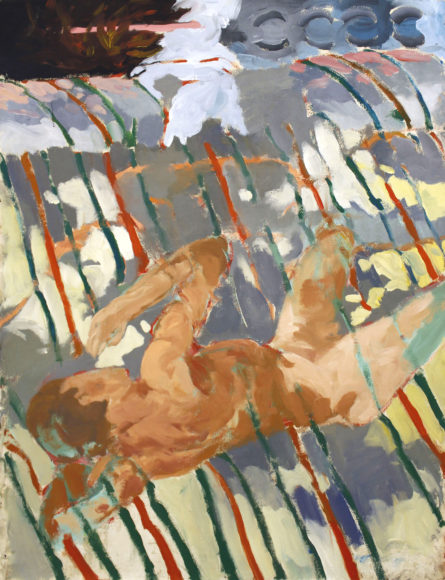
If you’re in Mexico City, don’t miss the solo exhibition of queer Portuguese artist João Gabriel, A Permit For That Fire, curated by myself at Galeria Mascota, on view through July 21st.
Often departing from pre-AIDS, 1970s gay pornographic imagery, João’s paintings deal with desire, loss and nostalgia. Disinterested in the contemporary ideals of masculinity and their portrayals, João turned to vintage gay pornography as a source material to address the male form. His near-obsessive revisiting of the pre-AIDS era speaks to a notion of inherited trauma, and a desire to question the boundaries of joy, fear and sexuality in contemporary queer culture.
The paintings, erotic in nature, carry a certain understatement, a suggestive quality that goes beyond the act of representation. Eerie and faceless protagonists merge poetically with nature in João’s built environment, projecting cryptic though timeless scenes of fantasy and longing that may speak to a large subset of the queer experience.
A Permit For That Fire features a series of recent paintings on paper and large canvases, which shows different facets of the artist’s work. At once seedy and lyrical, the title — a reference to the opening line of vintage porn film Sailor In The Wild — is an ode to the unsteady potential of homoerotic narratives in painting today.
…

Friday 06.15.18
CAST OF CHARACTERS – OPENING RECEPTION
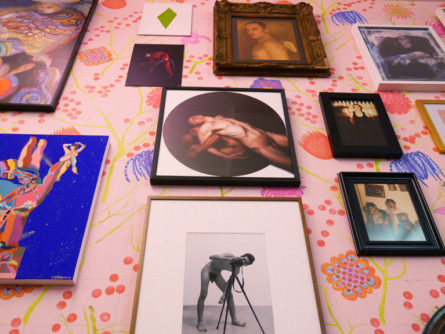
We wrote about this a few weeks ago because they had began a Kickstarter to get the proper funding in check. Well, I am happy to report they did and this week Liz Collin’s salon-style exhibition of over 95 queer artists will be on view at BGQSD. “Cast of Characters features a remarkable group of artists showing special works in a site-specific context. The show opens during PRIDE month and will be a grounding and celebratory site for folks to see a broad representation of LGBTQ creativity and life today in a context that queers a design strategy originated in traditional and formal domestic spaces.” The opening reception for the public is June 15, from 6:00PM-9:00PM.
Featuring artists GAYLETTER loves and supports, like Vincent Dilio, Doron Langberg, Zanele Muholi, Mickalene Thomas, Kia LaBeija, Troy Michie and more, the enormous group was cast to set the precedent for how large of a scale there is for queer representation in 2018. RSVP is required for the public opening — search on Facebook for event.
Below are a few images from the preview of the show:
Liz Collins (center), curator of the exhibition.
Free W/RSVP, 6:00PM-9:00PM, BGSQD at the Center, 208 W 13 St. NY, NY. …

Monday 06.11.18
Loewe Celebrates David Wojnarowicz
A limited edition t-shirt by Jonathan Anderson benefiting Visual AIDS
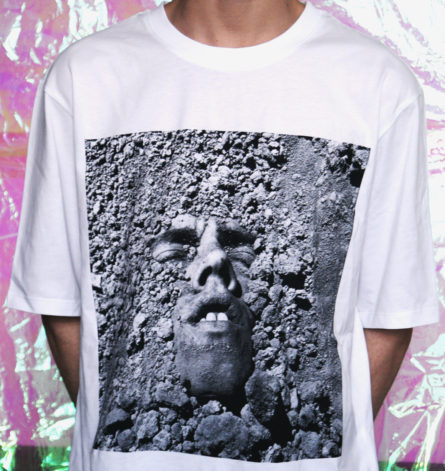
Loewe just launched a limited edition series of t-shirts featuring works by the American artist and activist, David Wojnarowicz (1954-1992). All of the proceeds from the series are going to Visual AIDS, an organization which “preserves and promotes the work of HIV positive artists and assists artists living with HIV/AIDS.” Visual AIDS also works to raise awareness about AIDS and create a dialogue through visual art exhibitions and publications. Designed by Loewe Creative Director Jonathan Anderson, the project serves to “foster awareness and honor Wojnarowicz as a courageous creator and activist.” The series features four of Wojnarowicz’s pieces printed on high-grade cotton crew necks.
Wojnarowicz became a protagonist of the local art scene in Manhattan’s East Village in 1978. Many of his works, both visual and literary, center on themes of ostracism and isolation drawn from his experience as a gay man. After being diagnosed with AIDS, Wojnarowicz’ art took on a vocal political stance and he produced some of the most important and challenging work around the AIDS crisis throughout the 1980s. His scathing honesty earned the ire of federal authorities, and his work continues to spark controversy and inspire in our own time of growing cultural divisions around critical social issues concerning freedom, justice and equality. In creating this series Jonathan Anderson seeks to honor Wojnarowicz’s legacy and, in keeping with the mission of Visual AIDS, maintain a dialogue about AIDS through art. The T-shirt project coincides with the Loewe Foundation’s exhibition of works by Wojnarowicz and Peter Hujar, on view at the label’s Gran Via store in Madrid from June through late August. …

Sunday 06.10.18
VOLUME 1 BY MICHAEL STIPE
The first in a series showcasing the artist's multifaceted practice.

Best known as the frontman of alt-rock band R.E.M., Michael Stipe is an artist in the most far-reaching sense of the word. His distinct vocals are hard not to recognize thanks to the popularity of tracks like “Losing My Religion” and “Shiny Happy People”. Stipe has also worked extensively in film, founding two production companies and acting as the executive producer behind well-known independent hits like like Being John Malkovich and Velvet Goldmine. His circle of friends — musicians Natalie Merchant, Tori Amos, Thom Yorke, Courtney Love, and the late Kurt Cobain, just to name a few — reads like a who’s who of the 90’s alternative rock scene. It should comes as no surprise that Stipe would extend his practice into the realm of the visual for his latest project — a photo book.
Volume I is the first in the series “presenting different aspects of Michael Stipe’s multifaceted artistic practice.” Here Stipe and co-collaborator Jonathan Berger work with photographs; there are thirty-five in total and through them Stipe plays an array of roles. He moves fluidly between subject, photographer, and curator, putting together his own photographs with found pieces from his collection. Present in condensed form are 37-years of Stipe’s artistic practice of creating and collecting materials, and he involves the two practices in Volume 1 as he conflates “figures in his own life with those in American history and popular culture,” focusing specifically within his experience as a queer man.
The book features many of his friends, lovers and fellow artists. …

Monday 05.07.18
DOUG MELNYK’S PYJAMAS
A sexy, shocking and endearing new zine edited by A.A. Bronson
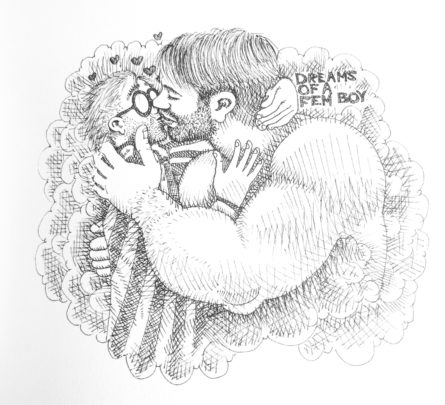
Doug Melnyk’s new ‘zine, Pyjamas, has been on my desk when it’s not on my dining table and when it’s not in bed with me. Needless to say, I love it!
In his signature playful, process-driven and unabashed style, Melnyk’s high quality scans detail original drawings that show the artist’s decision to move the angle of an ankle in one sketch and the subtle but declared use of color in another, highlighting erogenous zones or the environs in which his characters come to life. The passing of time in a single black and white image lets us watch as the smaller-guy (the protagonist) first clues into his curiosity and then let’s wander get the best of him, only to have the hand that leads him to pleasure become trapped by some midday dalliance — the pay-off being not just the reclined hardening hunk on the couch, but rather the reveal of the small guy’s hairy cheeks just above the lowered pyjama bottoms as he tumbles over and onto a big fellow.
And what to say about those offerings of glorious groups of athletes and college roommates? They’re simultaneously stimulating and cringe-worthy in the visual exploits of sexual fantasies turned everyday nightmare in our world of power imbalance. Like the hotel art included in a two-page spread of hijinks. It features some implausible meeting between a stag and a lion act as precursor to the single black guy, naked and in the mix of five other white guys, pouncing on the immature redhead and pinning him to the floor face-down as his cock is about to breach the exposed ass. …

Friday 04.27.18
Andy Warhol’s The Chelsea Girls
The Factory's hedonistic hit comes to print
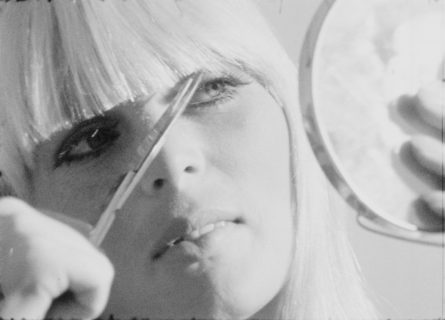
In 1966 Andy Warhol released The Chelsea Girls, a three and a half hour experimental film which would become his greatest commercial success. Part documentation, part experiment in hyperreality, the film is a series of vignettes in which Warhol’s superstars play altered versions of themselves. Everything is shown in split-screen and the audio alternates between the two videos. In one sequence German singer Nico cuts her own bangs. In another the artist Brigid Berlin plays herself (nicknamed “the Duchess”) wearing gold chains and shooting up amphetamines. In one of many scenes shot at the Chelsea Hotel, Mary Woronov, playing Vietnam War-era radio host Hanoi Hannah, barks at Warhol’s Ingrid Superstar, Angelina “Pepper” Davis and Susan Bottomly, also known as International Velvet. The Chelsea Girls is dark and glamorous and mundane, and above all, voyeuristic. Upon its release audiences were captivated, critics were polarized but ever opinionated, and the film would go on to be played internationally for two years.
Since then, apart from occasional museum screenings, The Chelsea Girls has been nearly impossible to see. However in honor of their 24th anniversary, the Andy Warhol Museum is undertaking the major project of digitizing hundreds of Warhol’s films— including The Chelsea Girls. Coinciding with the museum’s project is the release of Andy Warhol’s The Chelsea Girls, a “deluxe treatment of the 12-reel, split-screen film, featuring stills from the newly digitized film, previously unpublished transcripts and archival materials, and expanded texts about each of the individual films that comprise The Chelsea Girls.” …




